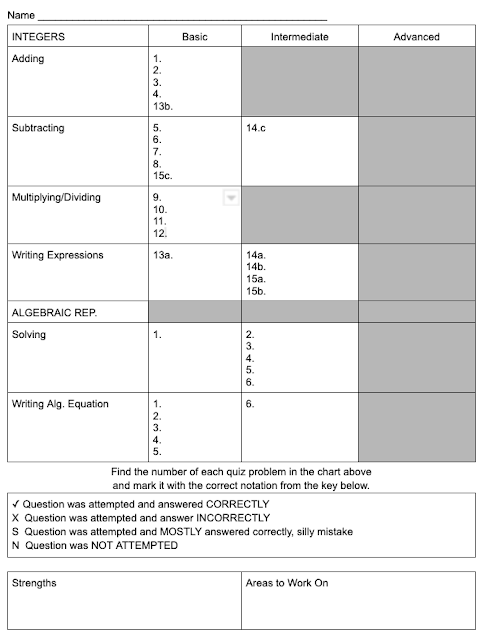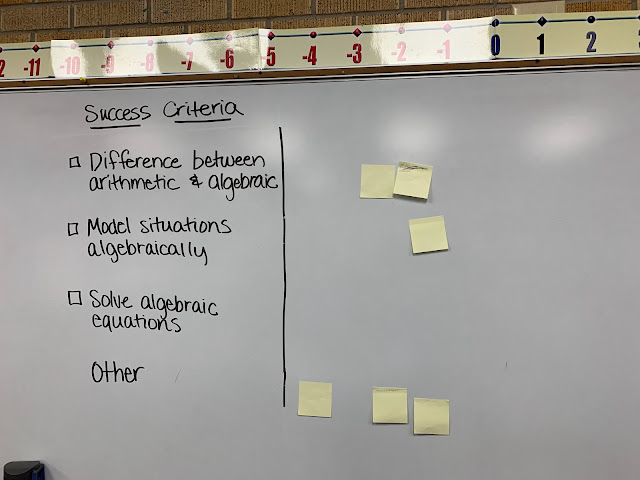Thursday, December 7, 2023
When a Mistake Reflects the Research
Thursday, September 21, 2023
Let's Talk About Flow
Thursday, September 14, 2023
Rubrics Making Learning Visible
Tuesday, September 12, 2023
Using Success Criteria to Help Students Visualize Their Learning
Saturday, August 26, 2023
Implementing Learning Targets and Success Criteria
Sunday, July 23, 2023
Visible Learning Meets BTC - Ch. 11 - A Vision
Visible Learning Meets BTC - Ch. 10 - Learning
Friday, July 21, 2023
Visible Learning Meets BTC - Ch. 9 - Relationships
Wednesday, July 19, 2023
Visible Learning Meets BTC - Ch. 8 - Success Criteria
Monday, July 17, 2023
Visible Learning Meets BTC - Ch. 7 - Dialogue
Monday, July 10, 2023
Visible Learnings Meets BTC - Ch. 6: Feedback
Friday, July 7, 2023
Visible Learning Meets BTC - Ch 5 - I Strive for Challenge and not Merely "Doing Your Best"
Saturday, June 24, 2023
Visible Learning Meets BTC - Ch 4: I am a Change Agent and Believe All Students Can Improve
Monday, June 19, 2023
Visible Learning Meets BTC - Ch. 3: I Collaborate with my Peers and Students
With being the only classroom in the school, well, the district really, that follows the BTC strategies, I can see where this could open up a great avenue for getting collaboration started over our impact in the learning process. With student thinking literally on the board for all to see, assessing our impact that all students can grow is so much easier I believe. It takes a focus though for truly "seeing" (listening) to each and every student to more precisely account for our impact.
We have to believe that "we cause learning". This is greatest joy of teaching, I believe, that I have the power, the magic, the impact, the ability, to cause learning. To see that light bulb of understanding...to hear a summary of their learning in their own words...to watch the successful completion of a problem is possibly the best feeling in the world as far as teaching goes.
Sharing expectations...in the BTC classroom, I feel like this is ever so important. Especially because when students come to my 8th grade classroom, the learning environment looks so different. So clearly stated high expectations is a must for a focused lesson.
I love the change in thinking of "less about how to teach" and "more about the impact of teaching." While BTC is a way of how to teach, there is a clear pathway to dig deeper into the impact of teaching.
Collaborating with Peers
I love the idea of the micro-teaching and viewing teaching videos under the lens of what is the impact of the teacher on learning. By allowing the teacher to voice their decisions for how they conducted the lesson, is a lot like what I do with my student teachers. Every decision I make, I feel like I must explain why I chose that one over the others I was mulling around. This seems easier with a student teacher, as we are both focused on the exact same lesson. With other teachers, either the same grade level or same teaching content/different grade levels, the dialogue will look differently than it does with a student teacher, but I think there is a benefit to having these conversations.
I also liked the idea for collaborating on the impact we have with specific parts of the lesson.
- Importance of motivation for the lesson introduction - create a list of motivation strategies and then reflect and discuss each with colleagues
- Assess the effectiveness of the factors of Visible Learning (table on page 36) based on our own teaching and discuss with cohorts
- Scrutinize one's own thinking and action while teaching, asking the questions, "What is effective?" "What is not effective?" "Why?" and "Why not?"
- Reflection Question on a quiz
- Thumbs Up/Thumbs Down if the activity met their learning needs
- Rating various activities as to their effectiveness for helping them learn: VWBs, note taking, consolidation, CYU, quiz rubrics, etc
Visible Learning Meets BTC - Ch. 2 - I See Assessment As Informing My Impact
- Which of my goals did I achieve in the lesson?
- What material did I successfully get across to the learners?
- Which methods turned out to be useful for fostering learning?
- Which media were useful for fostering learning?
Monday, June 12, 2023
Visible Learning Meets BTC - Ch 1: I Am An Evaluator of my Impact on Learning
- Exit Tickets
- Favorite Mistake
- Create a sticky note graph on VWB
- Concepts "mastered"
- Concepts still struggling with
- Questions
- This, That or the Other - Create a Basic, Intermediate, and Advanced problem. Students pick the hardest problem that they believe they can successfully complete.
- Notes for My Future Forgetful Self
- What are the students including in their notes that they have learned?
- What are they excluding?
- What questions are they writing down in place of notes?
- Quiz Rubrics (this would be more of a Summative Evaluation) - students can see where their strengths and weaknesses are based on the quiz they just took
- Check Your Understanding Accountability - when students complete a Check Your Understanding on their own, have them report in an exit ticket how many correct out of how many completed. This will give feedback to both the student and the teacher.
Preface - 10 Mindframes for Visible Learning by Hattie & Zierer
The Preface
I start this book with much anticipation! I have heard just brief snippets about it and as I am one that loves to learn new things, I am excited to see where this book will take my teaching!
My Why
Why do I teach the way I do? Simply said, I want students to find the joy that mathematical discovery and learning has to offer. All the patterns, the relationships, the a-ha moments, the connections, the wonder. All. Of. It. I approach my teaching from the lens of the student. Why is this important? Why do I have to know this? Why is this way more efficient than that way? Why doesn't this work? Why does this work? Everything about my lesson planning is focused on the why. But that's not what this section is talking about, although I will say that it does apply quite nicely. This question is about why I do what I do. As my mathematical knowledge and instruction has morphed and changed over the years, overall I have seen growth. It is my desire, in one year's time with a group of students, to instill this way of thinking, this passion, this curiosity, this way of questioning what they are learning, into my students. It's really not just about the math. It's about becoming a better person. I just help them do it through the lens of numbers and calculations.
The Why Do I Do This Rather Than That
Oh my word. This is the constant dialogue that is running through my mind for almost every single lesson. Even lessons that have stood the test of time, good problems that I know will increase learning in my classroom, I still run through all the options of why this problem is a good fit for this particular group of students or if I should change it up. Most often, the why-do-I-do-this-rather-than-that conversation has to do with a particular instructional strategy for that problem. After teaching 28 years, my toolbox of instructional strategies continues to grow. This is probably hands-down the best thing of being an experienced teacher. Being able to tap into these strategies, knowing how they work and what the main outcome will be if applied in the learning process. Most often, these conversations in my mind happen after each day of teaching as I prepare for the next day. With lesson plans written weekly, I have a framework of what I'll be doing, but it's the day to day conversations I have with myself of why one particular strategy would be better than another, that makes teaching meaningful to me. Sometimes, these conversations happen on the fly in the middle of the lesson. Even that most thought out lesson can sometimes take a nose-dive and a new instructional strategy needs to be brought to light, prompting the immediate question of "why should I choose a new strategy?" What's not working? Why is it not working? What needs adjusting? Can the same strategy be used with some tweaking?
I have heard the statistic that teachers make thousands of decisions a day. It's the answers to these questions that will have the most impact on student learning...not the simple ones of "no, this isn't a good time to use the restroom." LOL!
The 10 Mindframes
I know that each mindframe will be reviewed in much more depth, but as I read through the list, I was able to check off each one. Now, I'm interested to learn more about each one to see if I am viewing it in the same light. At this time, #7 grabbed my attention. I believe I engage waaaaaay more in monologue than dialogue about Learning Focus while at school. I miss the days of math conversations at ESSDACK or with my math groups from other districts. Two of us still meet up to have these conversations about once a year, not nearly enough. Collaboration with the other two math teachers in our building is beneficial, but I think it could be improved to have a common focus. Maybe this book, will spark those conversations that I've been missing from the past. Also, here lately I've had several student teachers. These conversations are always fun as they mostly focus on the "why".











